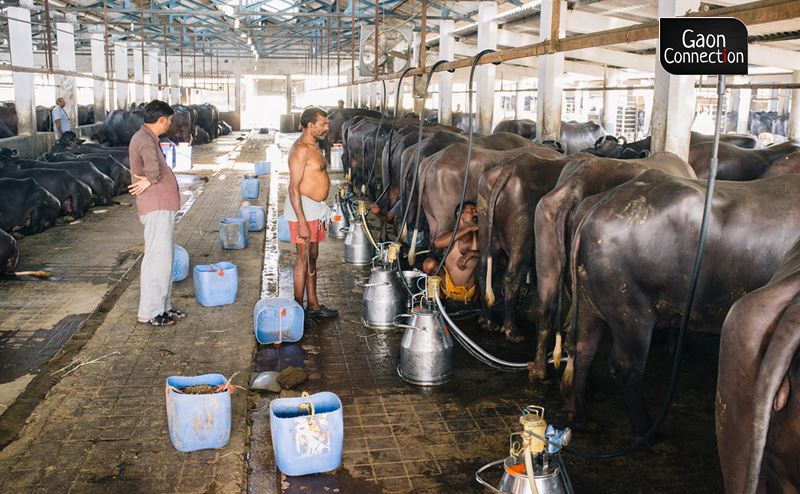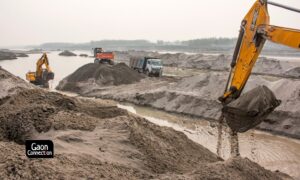After one year and seven months, Amul, India’s largest dairy co-operative company, has raised the price of milk in Delhi, Punjab, Gujarat and several other states. The last time it raised the price of milk was in December 2019 when it hiked the cost by Rs 2 a litre.
At a time when unemployment, loss of livelihood and hunger stare the country in the face because of the pandemic, a hike in the price of milk will have an adverse impact on consumers, this news will bring some cheer to dairy farmers.
“It has been a long time since the price of milk was hiked. And,the summer months already see a drop in milk production,” Manish Bharthi, a dairy farmer from Meerut in Uttar Pradesh, told Gaon Connection. “Besides, the price of everything else including petrol, diesel, fodder and medicines, has gone up. But not of milk,” he pointed out.
Price increase
A press release on June 30, last month, the Gujarat Co-operative Milk Marketing Federation Ltd., stated that the hike of Rs 2 a litre will increase the MRP by 4 percent that is much lower than the average food inflation. The price revision is across the country wherever Amul markets its fresh milk.
Also Read: All froth and fury: Milk as protest tool in Haryana
Amul milk will cost Rs 2 a litre more from now, the press release announced. The new price hike is applicable to all the Amul brands such as Sona, Taaza, Shakti, T-Special, etc as well as other cow and buffalo milk.
Amul is the country’s largest Fast Moving Consumer Goods Company (FMCG) and works with milk cooperatives from 18,500 villages. It owns approximately 80 dairy plants and has an annual turnover of Rs 500 billion.
Justifying the rise in the milk price, the release explained that food inflation had made it necessary. There has been a 30-40 per cent hike in packaging costs, 30 per cent increase in transportation and another 30 per cent hike in energy expenditure. The press release further stated that the price of buying the milk from dairy farmers had risen by 6 per cent. Eighty paise out of every rupee is given to the dairy farmer.
Also Read: Milked Dry: Dairy farmers in Madhya Pradesh protest
Pandemic woes
Since the pandemic and lockdowns, a 60-kg sack of cattle feed that cost Rs 1,450, is now priced at Rs 1,850, a hike of Rs 400.
“Because the petrol-diesel price increases almost every other day, there is a corresponding price hike in cattle feed too. But the price of milk has remained unchanged,” Shamsher Singh Arya, state president, Gaushala Association, Haryana, told Gaon Connection. “Along with Amul, the price of milk elsewhere should be revised too. It will bring some relief to the beleaguered dairy farmers,” he added.
Also Read: Brimming over with milk, but no takers as COVID19 lockdown impacts dairy farmers
In March, earlier this year, protesting against the rise of fuel prices, the Sathraul khap panchayat in Hisar district of Haryana, decided not to sell any milk. Between March 1 and March 5, dairy farmers from more than 100 villages did not sell milk.
In the 20th cattle census in 2019, there are 145.1 million cows and 109.8 million buffaloes in the country. The number of milch cattle stands at 125.2 millions.
According to a press release on February 18, 2020 by the Ministry of Fisheries, Animal Husbandry & Dairying, in 2014-15 the production of milk in the country stood at 146.3 million tonnes. By 2018-19 it had gone up to 187.7 million tonnes of milk, an increase of 6.4 per cent.
Beleaguered dairy farmers seek relief
However, that increase had not reflected on the income of the farmers. “While the production of milk in the country has gone up, the dairy farmers have seen no monetary benefit from it,” Bharathi said. “Dairy farmers have incurred heavy losses and many of them have also closed down their dairies,” he added.
There are approximately 80 million rural families in India that are associated directly or indirectly with the dairy industry. Most of them are either farmers who are landless or have small or medium holdings. For many of them, the pandemic has rung a death knell for their source of livelihood.
Read the story in Hindi


















